|
|
|
Birds of Aruba, Curaçao, and Bonaire: A Site And Field GuideJeffrey V Wells, Allison Childs Wells
Comstock Publishing
2017
"Birds of Aruba, Bonaire, and Curacao is the essential guide for anyone traveling to those islands. It showcases the more than 280 species seen on Aruba, Bonaire, and Curacao and provides descriptions of and directions to the best places to bird, from the famous white sand beaches to hidden watering holes to the majestic national parks."
|
Buy from amazon.co.uk 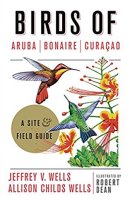
|
|
Bird Wildlife of ArubaGregory M. Peterson, Annette H. Peterson-Bredie
Photography: Gregory M. Peterson, Albert A. Peterson
KIT Publishers
2016
"The book contains full page photographs of over two hundred species of birds taken in Aruba's wildlife. A checklist, for scientific and educational purposes, is at the end of the book containing the names of all bird species that can be found in Aruba. Where possible, the status (resident, migrant, vagrant, introduced) and abundance (common, fairly common, uncommon, scarce, and rare) of the particular bird species will be added to the checklist."
|
Buy from amazon.co.uk 
|
|
Birds of Aruba, Curaçao, and BonaireBart de Boer, Eric Newton & Robin Restall
Helm Field Guides
A & C Black / Helm
2012
"The Netherlands Antilles comprises three main islands off the coast of
northern Venezuela. These are Aruba, Curacao and Bonaire . They are
major tourist destinations, especially popular with divers, and also
attract many visitors from Holland and elsewhere. The colour plates are based on the bestselling Birds of Northern South America, but many new images have been painted specially for this book. The authoritative text highlights the key features needed to identify each species in the field, and the plates illustrate every distinct plumage and race."
|
Buy from amazon.co.uk 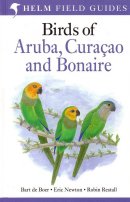
|
|
Birds of Aruba, Curaçao, and BonaireBart de Boer, Eric Newton & Robin Restall
Princeton Field Guides
Princeton University Press
2012
"Located in the southern Caribbean off the coast of Venezuela, the islands of Aruba, Curaao, and Bonaire are home to a colorful diversity of bird species. Birds of Aruba, Curaao, and Bonaire is the first comprehensive field guide to the birds of the region and the ideal companion for identifying the islands' remarkable avian population. This compact and portable book contains close to 1,000 superb color illustrations on 71 color plates and detailed descriptions of every species. Concise text on facing pages highlights key identification features, including voice, habitat, behavior, and status. This field guide is essential for all birdwatchers and wildlife enthusiasts interested in this part of the world."
|
Buy from amazon.co.uk 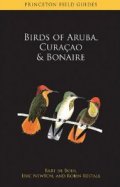
|
|
Seabird Breeding Atlas of the Lesser AntillesKatharine Lowrie, David Lowrie and Natalia Collier
Environmental Protection in the Caribbean (EPIC)
2012
"The Seabird Breeding Atlas of the Lesser Antilles makes available data and narrative related to Environmental Protection in the Caribbean's (EPIC) census of breeding seabirds in the Lesser Antilles. The book provides information on methodology, species profiles and distribution maps and tables by species and country/territory, and site specific threats. The Atlas reports key individual islands for breeding seabirds in the Lesser Antilles, nations or territories supporting the greatest number of globally and regionally important populations and clarifies the significance of the region in relation to Caribbean-wide populations. Species with restricted breeding ranges are also identified. The study covered 3,162 nautical miles and over 200 islands between 2009 and 2010. Every island, islet, or cay above the high-tide level capable of supporting seabirds was surveyed by land and/or sea. Surveys were conducted over a two-year period to account for variations in breeding cycles. The only islands not surveyed by EPIC were locations for which colleagues contributed recent data. A full seabird population survey for this region had never previously been undertaken. Existing records varied greatly from areas of intense research, to sites where data were based on anecdotal notes, sometimes dating back to the early 19th century. This ground-breaking study sheds light on numerous undocumented seabird breeding colonies, as well as colonies previously thought extirpated. The standardised methods and results will provide a baseline for the future monitoring of seabirds within the region and guide conservation priorities."
|
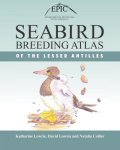 |
|
Checklist Of The Birds of Aruba, Curaçao, and Bonaire T.G. Prins, J.H. Reuter, A.O. Debrot, J. Wattel and V. Nijman
Netherlands Ornithologist Union
2009
"This volume documents all 280 species of birds ever recorded as breeding, wintering, migrating, or visiting the islands of Aruba, Curacao and Bonaire in the southern Caribbean Sea. It brings the avifaunistic information up-to-date, detailing the occurrence of all species. For the rarer species, all records are specified from the earliest up to 2008. Also included are details of the 15 important bird areas identified on these islands."
|
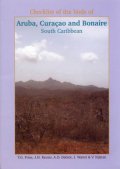 |
|
Checklist of the Birds of Northern South AmericaClemencia Rodner, Robin Restall and Miguel Lentino
Pica Press
2000
"This checklist, which covers all the species of birds found in Ecuador, Colombia, Venezuela, Aruba, Bonaire, Curacao, Guyana, Suriname, French Guiana and Trinidad & Tobago, recognizes 2,236 species. For each species, it gives information on subspecies in the region, distribution, altitudinal range, taxonomic notes and references."
|
Buy from amazon.co.uk 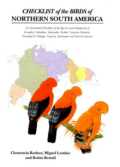
|
|
STERN Guide to the Birds of ArubaJ.H. Reuter
1999
"A guide that concentrates on the commoner species to be seen on the island. Includes a checklist of all species recorded."
|
 |
|
Nos Paranan - Onze Vogels - Our BirdsBart A. De Boer
Stichting Dierenbescherming Curacao
1993
A 120 page guide which cover the commoner species of Aruba, Bonaire, and Curaçao. Includes photographs of the birds and a sort account in three languages; Papiemento, Dutch, and English.
|
Buy from amazon.co.uk 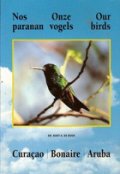
|
|
Birds of BonairePeggy Boyer
Stinapa Bonaire
1984
A 50 page guide.
|
Buy from amazon.co.uk 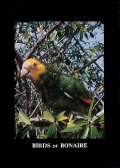
|
|
Birds of the Netherlands AntillesK.H. Voous
De Walburg Pers
1983
"Birds of the Netherlands Antilles' is a completely rewritten English version of 'De Vogels van de Nederlandse Antillen' published in 1955 and since long sold out and difficult to obtain second-hand. Whereas the first edition was primarily intended for use in the Netherlands Antilles and therefore was mainly written in Dutch, the present edition is meant for a wider circle of interest, including ornithologists and bird watchers from North and South America. Apart from 73 species of local breeding birds, the occurrence of 113 North American and 44 South American migrants and stragglers is described. Some of the last named come from as far north as arctic Canada and as far south as Argentina. The life of these birds under the tropical conditions of the Caribbean may be very different from that on their distant breeding grounds. 'Birds of the Netherlands Antilles' is actually a new book. It not only covers many more species than were known from the islands thirty years ago (252 instead of 147 species), but it also gives more details on occurrence, food and breeding habits. The book is no longer primarily intended to be a mere field guide, but is rather more a handbook in miniature of the birds of the Netherlands Antilles. In view of the great faunistic differences between the South Caribbean group of islands and the more northern Windward group, the book is divided in two parts, one dealing with the birds of Aruba, Curacao and Bonaire (236 species) and another describing the birds of St. Martin, Saba and St. Eustatius (122 species)."
|
Buy from amazon.co.uk 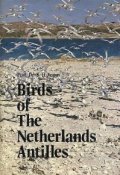
|
|
The Birds Of The Leeward Islands, Caribbean Sea
Including The Islands Of Aruba, Curacao, Bonaire, Islas De Aves, Los Roques, Orchilla, Tortuga, Blanquilla, Los Hermanos, Testigos Is., And Margarita
Charles B. Cory
Ornithological Series, Vol 1, No. 5
Field Museum Of Natural History
1909
"In the spring of 1908 Mr. John F. Ferry and Dr. Ned Dearborn made a short visit to the islands of Aruba, Curasao and Bonaire 'for the purpose of collecting zoological material for this Museum, Mr. Ferry devoting his time to Aruba and Bonaire, and Dr. Dearborn to Curasao; and in January of the present year (1909) Mr. Ferry re- turned to Curasao, where he chartered a schooner and made collections on the islands of Bonaire, Islas de Aves, Los Roques, Orchilla, Tortuga, Blanquilla, Los Hermanos, Testigos Is. and Margarita, the ornithological results of both of these expeditions being summarized in the present paper, together with a list of the species previously recorded from the islands by other writers."
|
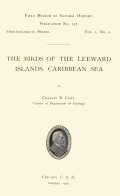
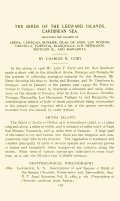 |
|
On the Birds of the Islands of Aruba, Curacao, and Bonaire
Ernst Hartert
Colour plate (Chrysotis ochroptera and Chrysotis rothschildi): J.G. Keulemans
Ibis: Volume 35, Issue 3, pages 289-338
1893
Opening lines: "The three Dutch West-Indian Islands of Aruba, Curacao, and Bonaire are situated off the western part of the north coast of Venezuela. Aruba, being only about 16 miles from Cape San Roman, the north point of the peninsula of Paraguana, is nearest to the continent; Curacao lies about 43 miles to the east; and Bonaire, the most oceanic of the three, still further to the east. Although near to the mainland, these islands do not, like Trinidad, belong geologically to the continent, but are of a different formation. They are surrounded by a coral-limestone belt, and for the most part are covered with a thick coral-limestone capping, and parts of coral-reefs are seen near Willemstad on Curacao, and on the east coast of Bonaire; while Aruba, for almost its entire length on the leeward side, is skirted by a coral-reef, inside of which is a calm and beautifu1 lagoon."
|

 |
|